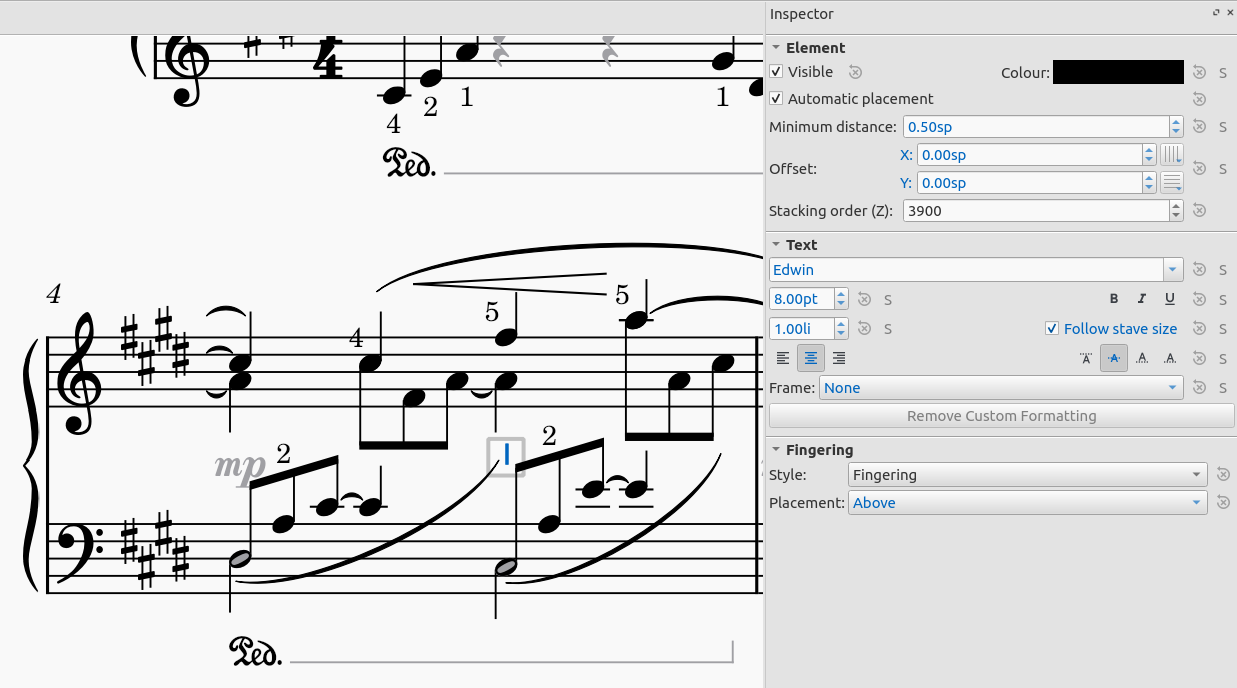Problem with Add Fingerings
A problem I've come across while adding fingerings. Is there an elegant way of solving this or is this actually an issue?
(This happens while using this (extremely handy) mode: https://musescore.org/en/handbook/3/fingering#easy-fingering)
Fingerings Below Note
If the default is to place the fingering ABOVE the note, you'll have a bad time.

a. If you first enter the fingering and then set Placement to "Below", it'll correctly change the placement. However, you can't click SPACE to move the fingering-selection to the next note, so you are forced to exit out of the mode and then re-enter on the next note.
b. If you set Placement to "Below", and then try to enter the number, well... you can't. Unless you know exactly how often to press Tab to go back to the score, your number-inputs won't reach the fingering-field. Also, you can't use your mouse to click on that text-field because that cancels the field somehow.
Comments
The default for fingerings on the bottom staff for piano is below when there is only one voice, because that's the usual standard. If there are two voices, the usual standard is to place the fingers on the stem ends, and that's the default too. So you should really need to be overriding this often at all - should be extremely rare in fact. If you have a situation where you feel the defaults aren't already correct, best to attach the score so we can investigate.
In the rare cases where override is needed, I'd personally recommend dealing with it later - until layout is finalized, it won't be a given where these places might even be. But if you do for whatever find yourself in a situation where you know in advance the standard position isn't what you want, you might try using the keyboard for that tooL: Esc X Alt+Right then your preferred shortcut for adding fingering should do the job. But if you do prefer using the mouse for this, after flipping position in the Inspector, Esc returns focus to the score, still leaving you in edit mode ready to continue.
In reply to The default for fingerings… by Marc Sabatella
Thank you for the reply, it helped a lot.
In my case, I tried to add the fingerings seen here...
![arab.jpeg arab.jpeg]()
... to this score: Arabesque_L._66_No._1_in_E_Major_NEW.mscz (which i got from here: https://musescore.com/classicman/scores/55396)
As you can see, the fingerings jump around a lot (not sure whether there's a system behind some of this madness). I tried to recreate this in Musescore to get used to it.
Which caused me some trouble, as Musescore didn't like the fingering-positions.
In reply to Thank you for the reply, it… by Mraco_o
The rules for fingering placement are a bit complex, but not that hard to understand.
In general, piano fingerings go outside the grand staff. So, above the top staff, or below the bottom staff. But if a staff has multiple voices, that changes - the fingerings go on the stem side (above for voice 1, below for voice 2). In some case to tuck those fingerings in tightly with the note as opposed to putting them outside the staff, this depends on a bunch more factors like whether it's a chord or single note and whether beams are involved.
All this should work automatically with very little need to flip things around. I don't see any fingerings in the score you posted, so I can figure out which notes you might have thought needed manual positioning. But as far as I can tell, only those fingerings that violate the normal rules should have required it, like the fingerings that the editor for whatever reason chose to put inside the staff in measure 7. I guess maybe they did it to avoid confusion with the triplet, but I'm not sure I agree with that solution.
In reply to The rules for fingering… by Marc Sabatella
I wasn't saying I don't understand the rules you said there were, I'm saying the sheet music I'm trying to recreate in Musescore seemingly doesn't tender to these rules.
I have attached an .mscz-file where the first page has the piano-fingerings i want. (the same fingerings as seen in the sheet music i got)
And there doesn't seem to be any consistent rules at play.
Example
1. In measure 8 the fingerings flip from above the stave to below.
2. Measure 1 and 11 have fingerings on the same side (below) even though the note-stems are pointing into different directions.
I had to do a lot of readjusting to the fingerings.
Arabesque_L._66_No._1_in_E_Major.mscz
In reply to I wasn't saying I don't… by Mraco_o
OK, thanks for the clarification. Since the score you posted had no fingerings at all I couldn't really tell.
FWIW, I would say you might have chosen to override the standard defaults and instead changed to the somewhat quirky non-strandard positioning shown in the PDF, but you didn't have to. I personally think you'd have been better off leaving them where they belong, where other professional engravers would have placed them. Only places I'd have recommended manual adjustments would have been where there was collision with tuplets, but even there I'd perhaps consider flipping the tuplet number instead, or just omitting it.